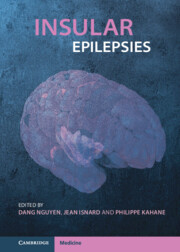Book contents
- Insular Epilepsies
- Insular Epilepsies
- Copyright page
- Contents
- Contributors
- Foreword
- Chapter 1 A Brief History of Insular Cortex Epilepsy
- Section 1 The Human Insula from an Epileptological Standpoint
- Section 2 The Spectrum of Epilepsies Involving the Insula
- Chapter 7 Clinical Presentation of Insulo-Opercular Epilepsy in Adults
- Chapter 8 Clinical Presentation of Insulo-Opercular Epilepsy in Children
- Chapter 9 Are Painful Seizures Specific to Insular Epilepsy?
- Chapter 10 The Role of the Insula in Temporal Lobe Epilepsy and Temporal Lobe “Plus” Epilepsies
- Chapter 11 Insular-Origin Seizures with a Hypermotor Presentation
- Chapter 12 The Role of the Insula in Sudden Unexpected Death in Epilepsy (SUDEP)
- Section 3 Noninvasive Investigation of Insular Epilepsy
- Section 4 Invasive Investigation of Insular Epilepsy
- Section 5 Surgical Management of Insular Epilepsy
- Index
- References
Chapter 8 - Clinical Presentation of Insulo-Opercular Epilepsy in Children
from Section 2 - The Spectrum of Epilepsies Involving the Insula
Published online by Cambridge University Press: 09 June 2022
- Insular Epilepsies
- Insular Epilepsies
- Copyright page
- Contents
- Contributors
- Foreword
- Chapter 1 A Brief History of Insular Cortex Epilepsy
- Section 1 The Human Insula from an Epileptological Standpoint
- Section 2 The Spectrum of Epilepsies Involving the Insula
- Chapter 7 Clinical Presentation of Insulo-Opercular Epilepsy in Adults
- Chapter 8 Clinical Presentation of Insulo-Opercular Epilepsy in Children
- Chapter 9 Are Painful Seizures Specific to Insular Epilepsy?
- Chapter 10 The Role of the Insula in Temporal Lobe Epilepsy and Temporal Lobe “Plus” Epilepsies
- Chapter 11 Insular-Origin Seizures with a Hypermotor Presentation
- Chapter 12 The Role of the Insula in Sudden Unexpected Death in Epilepsy (SUDEP)
- Section 3 Noninvasive Investigation of Insular Epilepsy
- Section 4 Invasive Investigation of Insular Epilepsy
- Section 5 Surgical Management of Insular Epilepsy
- Index
- References
Summary
Surgery for medically intractable childhood seizures originating in the opercular-insular cortex has only been undertaken in the last decade. While the need for SEEG interrogation and rates of post-operative seizure-freedom in children are comparable to adults, several important differences distinguish the pediatric experience. Most pediatric surgical candidates are pre-verbal or non-verbal and cannot describe subjective sensory or affective seizure manifestations. There is a higher representation of frontal lobe seizure semiology compared to adults, whereas ictal and inter-ictal electrographic discharges are typically more widespread throughout the cerebral hemisphere. Cortical malformations constitute the primary underlying pathological finding in the majority of pediatric cases. The recent surgical success in medically refractory children provides a compelling rationale to pursue further clinical studies and offer surgical candidacy in selected patients.
- Type
- Chapter
- Information
- Insular Epilepsies , pp. 82 - 97Publisher: Cambridge University PressPrint publication year: 2022
References
- 1
- Cited by

